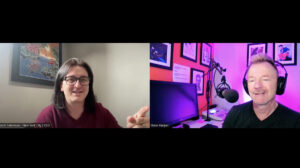No one will argue that talent development is not critical to an organization’s success, but 2020 made the case in ways that no CHRO ever could. Remote work, lay-offs, employee retention, management challenges, the need for additional technical skills, finding great talent beyond your immediate region – the challenges just kept coming.
Effective employee learning supports more innovative business strategy and bottom-line growth, as well as future competitiveness.
But the good news is that many leaders saw those impacts, and the really astute ones realized there were even more they weren’t seeing. And the takeaway from a year of pandemic disruption was the importance of their people. With a mostly remote workforce, the argument that a company is not a building or a storefront, but the people who make it work, was moot. And smart leadership is embracing that idea by putting resources and attention toward developing talent and increasing retention. Intelligent leaders see that investing in people shows a commitment to their success along with the organization’s.
Realigning resources
As companies plan for 2021, dealing with the lingering effects of the last year are critical. As Gallup suggested in a recent article on planning for a high-performance workplace in 2021, “the most effective interventions will support and amplify human development.”
While many companies are planning for a slow return to travel and in-person events in 2021, most organizations are still focused on remote gatherings. Budgets that went toward conferences, events, and travel in many cases are being re-directed toward learning and employee development, as well as the supporting systems and tools.
Smart leadership is embracing that idea by putting resources and attention toward developing talent and increasing retention.
Companies have also recognized their legacy systems need to be replaced or updated with more efficient and effective cloud-based technology that better supports people management and performance. With the explosive growth of online tools, among the most widely adopted are Human Resource Information Systems (HRIS), Applicant Tracking Systems (ATS), and Learning Management Systems (LMS). According to the marketing research website Markets and Markets, the global LMS market is expected to grow from USD 13.4 billion in 2020 to 25.7 billion by 2025.
Many development professionals realize the experiences of the last year make this a great time to argue for strengthening development offerings. Effective employee learning supports more innovative business strategy and bottom-line growth, as well as future competitiveness.
Next steps
If, like many companies, you took the opportunity to start the year with a culture assessment, (link to first article), you now have a list of opportunities for improvement. Expanding your development offerings is a great way to address issues while promoting employee learning and organizational success. Here are a few challenges common to many companies, and best practices for improvement:
Challenge: Leaders need to do a better job ensuring communications are frequent, transparent and cascaded down the organization
Best Practice: More frequent communications from leadership
Best Practice: Support for manager communications, including talking points for further dissemination and establishment of explicit feedback expectations; more frequent town halls within business units and across the organization
Challenge: Managers need help being better communicators
Best Practice: Skill-building sessions on giving and receiving feedback, active listening, and having difficult conversations
Challenge: Silos are impeding cross-functional collaboration and communication
Best Practice: Creating opportunities for cross-functional teams to work together more frequently
Best Practice: Strengthened internal communication across the organization to keep all colleagues informed; management communications stressing the importance of cross-functional collaboration
Challenge: Lack of clarity around your organization’s mission and purpose leaves employees uninspired and not empowered
Best Practice: Townhalls to discuss and share narratives telling the company’s story
Best Practice: Sharing narratives through other communication platforms, enabling employees to tell the story and take pride in the company’s achievements
Challenge: Inadequate onboarding procedures, exacerbated by remote work arrangements, are leaving new hires disengaged
Best Practice: Revamped onboarding program that includes company vision and mission, introductory meetings with a cross-section of colleagues, information on company DEIB initiatives, mentoring, volunteer, and development opportunities
Challenge: Added demand for employee wellness information and support
Best Practices: Increased company-sponsored employee assistance programs and wellness resources; company-wide messaging reiterating the importance of work-life balance and reducing stress
Best Practice: Support for managers’ efforts to encourage work-life balance
Challenge: Rethinking the office and office space; hybrid back-to-work models vs. remote working
Best Practices: Gathering employee input on returning to workplaces and creation of flexible roll-out plans; guidelines for managers and teams to set expectations and recognize individual circumstances
Sharing back-to-work or hybrid protocols to guide employees, while at the same time creating safe workspaces
No matter what challenges your organization is dealing with as we anticipate a gradual return to in-person work, the right talent development efforts can help you address these issues, leaving you stronger than before. The impacts of the global pandemic and increased social justice awareness are strong reminders of the continuing importance of talent development for any successful and growth-focused organization. Developing your people not only supports business success, but provides a powerful message to employees that their professional growth is a priority.
With lingering 2020 impacts and the likelihood of additional disruption ahead, a prepared and resilient workforce is your biggest asset.



